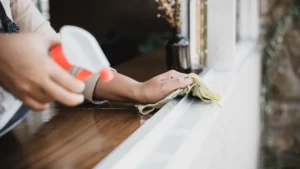Call us: (863) 983-8465
Cleaning Cloudy & Foggy Glass Windows ( 4 Working Methods)

Why Do Glass Windows Become Cloudy or Foggy?

Cloudy or foggy glass windows can be frustrating, but understanding the reasons behind this issue can help you tackle it effectively. Here are the main culprits:
- Hard Water Stains: Minerals from water can leave behind cloudy spots when it evaporates, especially after rain or cleaning.
- Dirt Buildup: Dust, pollen, and grime accumulate over time, creating a hazy film that blocks your view.
- Moisture Between Panes: If you have double-pane windows, a broken seal can allow moisture to enter, causing fogging inside the panes.
- Mold and Mildew: High humidity can lead to mold growth on window sills and tracks, which contributes to a cloudy appearance.
Best Methods to Clean Cloudy Glass Windows

Gather Your Supplies
- Vinegar
- Water
- Spray bottle
- Microfiber cloth
- Baking soda (for tough stains)
Step 1: Create the Vinegar Solution
Put equal parts of vinegar and water in a spray bottle. This natural solution is effective against hard water stains and dirt buildup.
Step 2: Spray and Wipe
Spray the vinegar solution generously onto the cloudy areas of the glass. Use a microfiber cloth to wipe in a circular motion for best results.
Step 3: For Stubborn Stains
If there are still stains, create a baking soda paste (mix baking soda with a little water) and apply it to the affected areas. Gently scrub with a sponge, then rinse with clean water.
Step 4: Final Wipe
After cleaning, use a clean microfiber cloth to dry the glass completely, ensuring no streaks remain.
Regular cleaning prevents cloudiness from building up. Clean your windows every few months for the best results!
Best Methods to Clean Foggy Glass Windows

Step 1: Identify the Cause
Foggy windows often result from moisture trapped between double panes. If that’s the situation, think about getting help from professionals.
Gather Your Supplies
- Dish soap
- Water
- Squeegee
- Microfiber cloth
Step 2: Mix the Cleaning Solution
In a bucket, mix a few drops of dish soap with warm water. This will help lift dirt and moisture.
Step 3: Clean the Surface
Dip a sponge into the soapy water and scrub the foggy areas. Make sure to check the corners and edges where dirt tends to build up.
Step 4: Use a Squeegee
After scrubbing, use a squeegee to remove excess water. Begin at the top and move straight down.
Step 5: Dry and Inspect
Wipe down any remaining moisture with a microfiber cloth, checking for any foggy spots.
If fogginess persists due to trapped moisture, consider replacing the window or contacting a professional for help. Regular maintenance can help prevent fogging in the first place!
How to Clean Window Sills and Tracks Thoroughly

Deep Cleaning Window Tracks

Step 1: Remove Debris
Start by using a vacuum attachment or a small brush to clear out loose dirt, dust, and debris from the window tracks. This is crucial for effective cleaning and helps prevent clogs.
Step 2: Soap and Water
For lightly soiled tracks, mix warm water with a few drops of dish soap. Use a sponge or brush to scrub the area thoroughly, ensuring you reach all corners and edges.
Step 3: Baking Soda and Vinegar for Deep Cleaning
For a more thorough clean, sprinkle baking soda along the tracks, then spray with vinegar. Allow it to fizz and sit for a few minutes before scrubbing with an old toothbrush or scrubbing brush to dislodge stubborn grime.
Professional Tip: After cleaning, be sure to thoroughly dry the tracks to prevent rust or mold growth.
Cleaning Window Sills

Step 1: Wipe Down Sills
Use a soft cloth dampened with a mild cleaner to wipe down window sills. This will remove dust and dirt without damaging the surface.
Step 2: Treat Stubborn Mold or Mildew
For stubborn mold or mildew, apply hydrogen peroxide or a vinegar solution directly to the affected areas. Let it sit for a few minutes, then scrub with a cloth or sponge.
| Window Cleaning Method | Pros | Cons |
| Vinegar and Water Solution | Natural, inexpensive, and effective for general grime. | It may not work on tough stains like calcium deposits. |
| Baking Soda Paste | Non-toxic, great for scrubbing away tough stains. | Can be abrasive if used too aggressively. |
| Commercial Glass Cleaners | Fast and highly effective for removing streaks and hard water stains. | Can be expensive and may contain chemicals some clients prefer to avoid. |
| Professional Cleaning Tools | Squeegees and microfiber cloths offer streak-free results, ideal for professional-level cleaning. | Requires proper technique to avoid streaking. |
How to Prevent Windows from Getting Cloudy or Foggy Again

- Clean your windows regularly to remove dirt and grime.
- Check window seals for damage and replace them as needed.
- Control indoor humidity with dehumidifiers to reduce moisture.
- Clean your windows every few months to keep them from getting dirty.
- Use high-quality window treatments to reduce moisture buildup.
Common Questions
Q1. How often should I clean my windows?
Wash your windows every few months to stop dirt from building up.
Q2. Why do my windows get cloudy?
Cloudiness is usually caused by dirt, hard water stains, or moisture between double panes.
Q3. Can I use vinegar on tinted windows?
Check with the manufacturer first, as vinegar may damage tinted films.
Final Thoughts
Maintaining clear and fog-free windows is essential for enhancing your home’s appearance and letting in natural light. By following the preventive measures outlined, you can significantly reduce the chances of your windows becoming cloudy or foggy. If you need professional assistance to achieve sparkling clean windows, our experienced cleaning team is here to help!
Contact Us Today!
For inquiries or to schedule a cleaning service, reach out to us at HomeyFind at Let us help you enjoy crystal-clear views!



